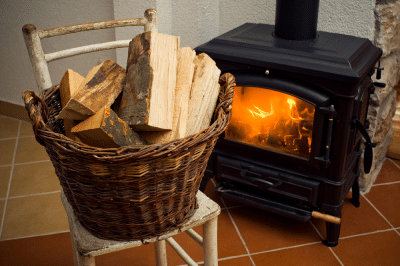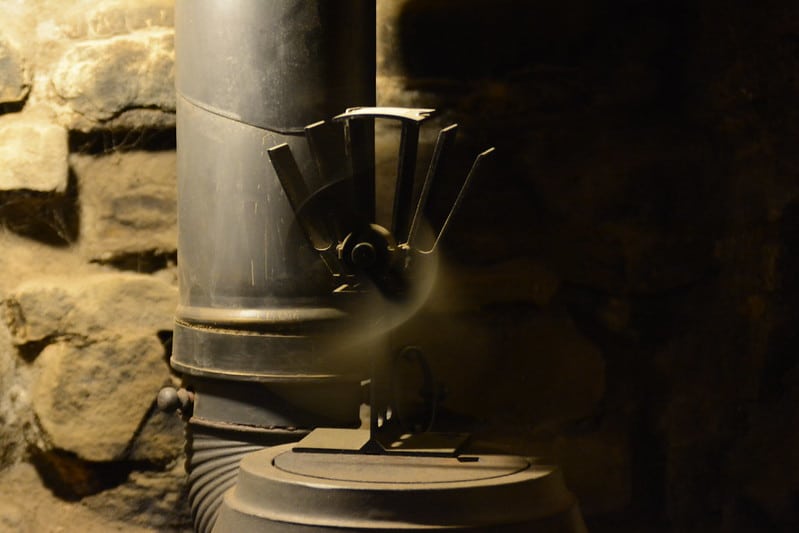If you are unfamiliar with stove fans, one of the first things you might notice when you see one is that they don’t have a power cord. They still manage to spin their blades like any other fan, but how is this possible? A stove fan uses heat as its power source. However, what does that mean? How does a stove fan work?
If you have never seen a heat powered fan in action, it might seem like a bit of magic is involved. But actually, a stove fan is quite simple if you understand a few basic principles. This article will teach you all about stove fans, how they work, and much more.
What Is a Stove Fan?
A stove fan sits atop the main surface of a wood-burning stove, a pellet stove, or a multi-fuel stove. Occasionally, they can also be attached to a stove pipe. They are small devices made from metal and, in general, contain three or four fan blades. Unlike cooling fans, wood stove fans feature exposed blades and are heat generated. These heat powered fans do not require an electrical connection to operate.
What Is the Function of a Wood Stove Fan?
A stove fan aims to distribute heated air created by wood-burning stoves more effectively and efficiently. A stove fan quickly spreads the hot air around the room instead of allowing hot air emanating from wood stoves to slowly permeate a room,
Does a Stove Fan Need Batteries?
The fact that stove fans are heat powered fans that create their own electricity means that they do not require batteries. Considering they don’t plug into mains power or need batteries, this is where the confusion about how a wood stove fan works start.
How Do Stove Fans Work?
Now that we know stove fans do not need mains power or batteries, how do log burner fans work?
A stove fan uses heat from warm air to create its power. This type of heat powered stove fan generates electricity using a Peltier device. The electricity generated powers a motor which then drives the fan blades. All that is needed is a room with both cold air and warm air, and a heat powered fan will start running.
A Peltier device can generate electricity when a temperature difference is present, as such is the case when a wood-burning stove is started in a room with cooler air. As the wood stove heats up, the heat produced transfers from the surface of the stovetop to the base of the fan by conduction.
The heat absorbed creates the temperature differential needed between the base of the fan and the cooler part of the fan above the Peltier device. The different temperatures on opposing sides of the Peltier device create an electrical current which is then transferred to the fan’s motor with connecting wires.
Finally, this electricity powers the motor, spinning the fan’s blades. As the blades spin, the heat output from the stove then starts heating the room.
@natepetroski Reply to @randywebb7 #narrowayhomestead #woodstoveheat #woodstove #stovefan #offgridliving
♬ original sound – Nate Petroski
Wood Stove Fan FAQs
To better understand the mechanism of a stove fan, we will answer some of the basic questions about this device.
At what temperature do stove fans work?
We know wood stove fans require warm air to work, but how warm or hot does the temperature need to be to get the fan’s blades spinning?
Stove thermometers have an operating temperature range that differs slightly from one device to another. However, most stove fans start working around 50 to 80 degrees Celsius and max out around 340 to 360 degrees Celsius. This means that many wood stoves will be able to trigger a stove fan fairly quickly once a fire is started.
Are stove fans safe to use?
If the top of the stove becomes too hot and exceeds the maximum operating temperature of a stove fan, a safety device should react to prevent possible damage to the motor. Normally, the safety device is a bimetallic strip that curls and lifts the fan off the top of the stove to help cool it down.
Where do you place a stove fan?

Ultimately, you want to place your stove fan where heat from the stove will have the best effect on both the fan itself and the room’s temperature. The best placement for most stoves and fans is on top of the stove’s main surface near the rear.
However, if you do not have enough space or your stove does not have a smooth, level top surface, you may need to experiment until you find the ideal location for your heating purposes. Often, this is why people choose a model that can attach to a flue pipe.
Do stove fans work?
Stove fans are designed to move hot air around the room faster, but some people doubt their effectiveness. This is because many stove fans are poorly built and have an inferior design, resulting in low air circulation. Also, some people may expect a bit too much out of their stove fan, which leads to disappointment.
You should know that stove fans do work. They will start running on heat alone and can increase airflow. But don’t expect them to magically heat your room in a few moments.
Do you need a stove fan?
Not all wood-burning stoves need a stove fan to help spread more heat around a living space. If your stove is in a small space and you don’t tend to experience cool air in particular spots around the room, then you may not need a stove fan. Or, if you always sit fairly close to your stove, a fan may also be unnecessary.
If your stove is in a big room, a stove fan may be beneficial. Heat travels faster when aided by a fan.
Types of Stove Fans
While most stove fans have a similar design, there are a few key differences. For example, the number of blades on the fan and the way it attaches to your stove can vary.
Stove fans can have either two, three, or four fan blades. The number of blades, and more importantly, their shape, can drastically affect how efficient a wood stove fan truly is.
Some designs feature two wood stove fans connected to form one single device. Are two stove fans better than one? Depending on the size of the room, yes, two can be better than one.
Different models of stove fans also vary in how they are installed. Some simply sit on top of a stove, while others can be attached to the flue pipe.
Stove Fans Explained
So, the next time someone asks you, ‘how does a stove fan work?’ you’ll have an answer at hand! A stove fan is a heat powered device that, as you now know, has a simple operating process. All that is required is a temperature differential and a bit of time. While this may not be the magical explanation some were hoping for, it clarifies some confusion. Whether you decide you want a new stove fan or not, at least now you know precisely why, and there shouldn’t be any more mystery surrounding their functionality.
Let us know what you think in the comments below.
Additional Resources
- How Does an Electric Cool Box Work
- How Do Induction Pans Work
- How Does a Microwave Work
- How to Repair an Ice Maker
Tom is a former chef turned full-time food blogger. He has always been passionate about food, and loves nothing more than experimenting in the kitchen and sharing his recipes with others. Tom’s blog is one of the most popular food blogs on the internet, and he has won numerous awards for his cooking. When he’s not blogging or cooking, Tom enjoys spending time with his wife and two young children.

